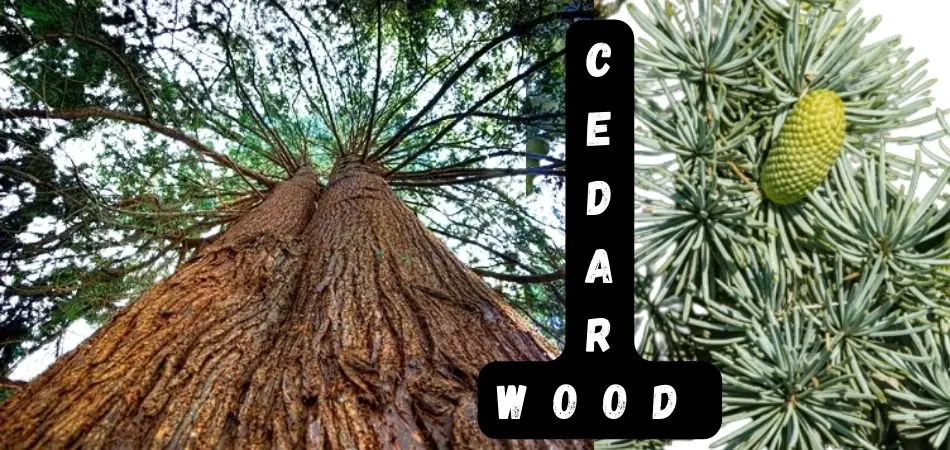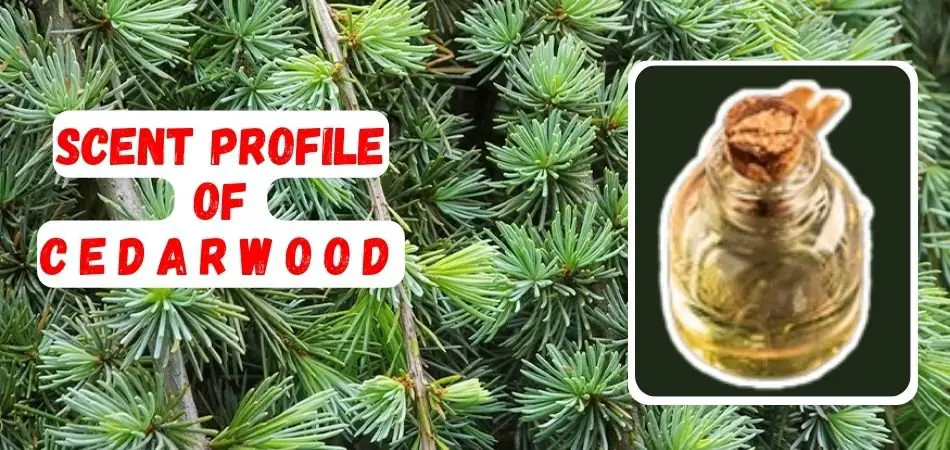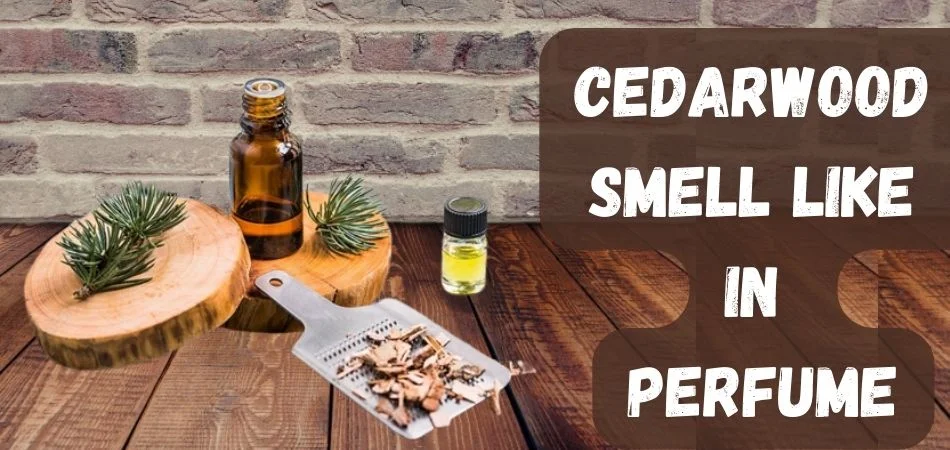The unique, aromatic profile of cedarwood has long captivated the senses, creating an indelible mark in the world of perfumery. While distinctly woody, there’s more to this scent than meets the nose. Here, we’ll also touch upon the spicy allure of black pepper notes.
Cedarwood, with its deeply rooted legacy in perfume-making, evokes an earthy, warm aroma that’s been cherished for ages. Beyond its rich scent profile, cedarwood is emblematic of the very art of perfumery itself – a celebration of nature, nuance, and the timeless bond between scent and the soul.
The fragrances we adorn ourselves with have an uncanny ability to elicit emotions, bringing forth distant memories or creating new ones. Just as a melody can transport us to another time, so too can the whiff of a familiar scent. Cedarwood is one such iconic fragrance note, enchanting and grounding, and has played a crucial role in this sensory dance.
Origins of Cedarwood

Historical Uses of Cedarwood in Perfumery and Its Cultural Significance:
The legacy of cedarwood is as ancient as civilization itself. The Egyptians revered it, not just for its aromatic properties, but also for its preservation qualities, using it in the mummification process.
In other ancient cultures, cedarwood oil was a symbol of protection and wisdom, often used in religious ceremonies and rituals. Its warm, woody scent has been captured in countless perfumes, making it a staple in the fragrance world for its ability to provide depth, longevity, and a certain timeless quality.
Different Types of Cedar Trees and Their Geographical Locations:
While ‘cedarwood’ might sound singular, it’s a term that encapsulates the essence of several different types of cedar trees. The most prominent types include:
- Atlas Cedar: Native to the Atlas Mountains in Morocco and Algeria, this tree offers a scent that is sweet, woody, and somewhat reminiscent of the warm sun hitting the forest floor.
- Himalayan Cedar: As the name suggests, it originates from the Himalayas. Its scent is dry, soft, and woody with a slightly smoky nuance.
- Texas Cedar: This variety from North America boasts a robust, crude, and deeply woody aroma, often likened to the scent of a pencil.
- Virginia Cedar: Another North American native, the Virginia Cedar has a profile that’s fresh, sharp, and distinctly woody.
The Scent Profile of Cedarwood
Primary Scent Notes: Woody, Resinous, and Balsamic:
At the heart of cedarwood’s aromatic profile is its unmistakably woody essence. This raw, earthy aroma often evokes the sensation of standing amidst a dense forest, enveloped in nature’s embrace. There’s also a resinous undertone, reminiscent of the rich, sticky sap that oozes out of tree barks.
This resinous quality lends a deep, velvety richness to the scent. Additionally, many cedarwoods carry a balsamic sweetness, which brings a subtle warmth and comfort to the olfactory experience.

Secondary Notes: Hints of Spice, Camphor, or Sometimes a Pencil-like Smell:
Lurking behind the dominant woody notes are the more subtle nuances that give cedarwood its multifaceted character. There’s often a hint of spice that adds a touch of invigorating warmth, making the scent all the more enticing.
Additionally, some cedarwoods exude a camphoraceous note, providing a refreshing coolness that contrasts beautifully with its inherent warmth. The pencil-like aroma, particularly prominent in the Virginia and Texas cedar varieties, adds a nostalgic touch, reminiscent of freshly sharpened pencils and days spent in school.
Evolution of the Cedarwood Scent When Exposed to Air (How it Starts and How it Settles):
Like a well-orchestrated symphony, cedarwood’s scent undergoes a captivating evolution upon exposure to air. Initially, the top notes – usually the spicy and camphoraceous hints – make their presence felt, invigorating the senses.
As time passes, these gradually give way to the heart of the fragrance, the dominating woody and resinous tones. Eventually, the scent settles into a warm, balsamic sweetness, which can linger for hours, providing a comforting, grounding aroma that feels both familiar and exotic.
The Role of Cedarwood in Perfume Compositions
| Component | Aroma Profile | Function |
| Top | Fresh, citrus | Introduce fragrance |
| Heart | Woody, aromatic | Enhance complexity |
| Base | Warm, earthy | Provide longevity |
Base Note: Its Importance in Adding Depth and Longevity to Perfumes:
In the realm of perfumery, cedarwood is celebrated as a quintessential base note. This means it serves as the foundation upon which other, more volatile notes are built.
Its inherent depth and richness provide a sturdy anchor, giving perfumes a lasting quality. Furthermore, its longevity ensures that the fragrance doesn’t dissipate quickly, allowing the wearer to enjoy the scent for prolonged periods.
Blending Characteristics: How Cedarwood Interacts with Other Notes (Floral, Citrus, Musk, etc.):
Cedarwood’s versatile aroma makes it a cherished ingredient in a perfumer’s palette. When blended with floral notes, it offers a grounding contrast, preventing the scent from becoming overly sweet or cloying.
Paired with citrus, cedarwood’s depth accentuates the zest and sparkle of notes like bergamot or lemon. Against musk’s, cedarwood provides a textured backdrop, allowing the musky notes to shine without overwhelming the senses.
Common Pairings: Other Ingredients that are Often Combined with Cedarwood in Perfumes:
Cedarwood’s harmonious nature means it pairs beautifully with a myriad of ingredients. Some common pairings include:
- Vetiver: Both being woody, they complement each other, with vetiver adding an earthy, grassy touch.
- Sandalwood: This combination results in a creamy, rich, and deeply meditative scent.
- Patchouli: The sweet, slightly musky scent of patchouli intertwines wonderfully with cedarwood’s resinous tones.
- Lavender: The aromatic freshness of lavender juxtaposed against cedarwood creates a calming, therapeutic aroma.
- Rose: Cedarwood’s depth provides a base that allows the romantic, lush scent of rose to flourish.
Benefits of Cedarwood in Perfumes
Longevity: How Cedarwood Can Enhance the Staying Power of a Perfume:
One of the primary reasons for cedarwood’s ubiquity in perfumery is its impressive staying power. As a base note, cedarwood has a molecular structure that evaporates slower than most other notes.
This means that when it’s incorporated into a perfume composition, it helps anchor the more volatile top and middle notes, extending the overall life of the fragrance on the skin. With cedarwood as a foundation, perfumes can linger and evolve for hours, creating a lasting olfactory journey.
Neutralizing Other Overpowering Scents:
Cedarwood’s balanced scent profile can serve as a harmonizing agent in complex fragrance compositions. In instances where a particular note might be overly dominant, threatening to overshadow other elements, cedarwood can help neutralize and balance the composition.
Its mellow, woody aroma can smoothen out the rough edges, allowing other notes to shine through without being overpowered.
Inducing Relaxation: The Therapeutic Properties of Cedarwood’s Scent:
Beyond just the realm of perfumery, cedarwood has been revered in aromatherapy for its calming properties. The scent is believed to induce feelings of relaxation, grounding, and mental clarity.
When present in perfumes, it provides not just a rich olfactory experience but also a subtle therapeutic effect. Wearers often find fragrances containing cedarwood to be soothing, making them perfect for stressful days or moments when one seeks solace and calm.
Comparing Cedarwood with Other Woody Notes
Cedarwood vs. Sandalwood:
While both are quintessential woody notes, they have distinct personalities. Cedarwood is sharp, clean, and can sometimes have that pencil-shaving aroma, while sandalwood is creamier, often described as milky, warm, and rich. Sandalwood also has a slightly sweet undertone, making it more opulent and luxurious in comparison to the drier cedarwood.
Cedarwood vs. Vetiver:
Vetiver is a grass root, and its scent is earthy with green undertones. While cedarwood is distinctly woody, vetiver leans more towards a damp, earthy, and smoky scent. Think of cedarwood as the dry, crisp forest floor and vetiver as the wet soil after a rainstorm.
Cedarwood vs. Agarwood (Oud):
Agarwood, or oud, is one of the most prized and expensive ingredients in perfumery. Originating from the resin of the Aquilaria tree, oud has a complex scent profile: musky, sweet, spicy, and woody. In contrast, cedarwood is cleaner and less intense.
While both are woody, oud’s richness and depth make it a powerful and dominant note in fragrances, often overshadowing other ingredients. Cedarwood, being more subdued, often plays a supportive role, enhancing and grounding other notes.
In the grand tapestry of perfumery, cedarwood holds its own against other woody notes, not just for its scent but for the versatility and balance it brings to fragrance compositions.
Popular Perfumes with Dominant Cedarwood Notes
Comme des Garçons ‘Wonderwood’:
An aptly named fragrance, ‘Wonderwood’ is a deep dive into the forest with an overdose of woodsy notes. Among them, cedarwood stands out prominently, creating a scent that’s both clean and complex. The perfume is a symphony of wood – blending not just cedarwood but also sandalwood, patchouli, and vetiver. Cedarwood here provides a crisp, sharp freshness, reminiscent of splinters from freshly cut wood.
Le Labo ‘Cedre 11’:
Crafted with an emphasis on the warm and enticing aromas of cedar, this fragrance wraps you in a comforting embrace. The cedar note is accented with hints of vanilla and amber, creating a beautiful juxtaposition of rawness and sweetness.
Tom Ford ‘Oud Wood’:
While oud is the star of this fragrance, cedarwood plays an essential supporting role. It balances the intensity of the oud, offering a cleaner, fresher dimension to the scent. The result is a sophisticated and modern take on traditional woody fragrances.
Serge Lutens ‘Cèdre’:
This perfume pays homage to the majestic cedar tree. Although it infuses the richness of tuberose and musk, the heart remains distinctly cedar. The fragrance exudes a creamy, almost resinous cedar aroma, making it a must-try for cedarwood aficionados.
Atelier Cologne ‘Cèdre Atlas’:
A journey through the Atlas mountains, this fragrance captures the essence of cedar trees swaying in the breeze. Paired with citruses at the top and a base of jasmine, it offers a refreshing take on the classic cedarwood note, making it both vibrant and deep.
Concusion
Cedarwood’s legacy in perfumery is as enduring as the majestic trees from which it originates. Its versatile scent profile, ranging from fresh to resinous, allows it to be both the star and the support in numerous fragrant compositions. Its therapeutic and grounding properties add another layer of appeal, making it more than just a fragrance ingredient but also a source of solace for many. Perfumery, at its heart, is about exploration and connection.
So, for those who haven’t yet had the pleasure, diving into the world of cedarwood-scented perfumes can be a revelatory experience. It’s not just about identifying a scent but also about forming a bond with it, letting it evoke memories, emotions, and dreams.


